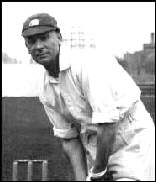| |

|
|
|
|

Jamnagar is the first places to make sporting history in this country, this is the city of Ranjitsinhji and Duleepsinhji, maharajas of cricket and of this former princely state. When Ranjitsinhji, a maharaja and graceful batsman, represented England while he made history as the first Indian to play test cricket.
He was a progressive ruler, the Ranji Trophy is very seriously battled over for the glory that goes with his name.
The Cricket bungalow : The Ajit Sinh Pavilion was constructed in 1908.
The other International Cricket Players from Jamnagar are : Arjun Sinh, Vinoo Makad, Karsan Ghawari, Salim Durani, & Ajay Jadeja.
The present Shri Jam Sataji, also fondly called Shatrushalyasinhji, a right hand batsman & off break baller, was also a good Ranji trophy player.
|
|
|
K S Ranjitsinhji (Ranji)
One of cricket's greatest players, 
He was the pioneer of the 'leg glance', a
shot he made his own at a time when people could not even contemplate playing
across the line. His cutting and driving, too, were superb. A useful change
bowler and a safe catcher in the slips, Ranjitsinhji was the complete
cricketer.
He was born on September 10, 1872, in
Sarodar, Jamnagar.
At the age of 16 that he made the tough
tour of England. Before his emergence, there was no inkling that India could
produce a cricketer of quality. But it wasn't easy.
Ranjitsinji began his cricket career with
Cambridge and earned his `Blues' in 1893. Initially he found it hard to break
into the team and only when F.S Jackson (later captain of England) became
captain did he finally make it. He, then, moved on to play cricket with Sussex
(1895). He made 77 and 150 on his debut for Sussex against MCC at
Lord's.
His style was so unorthodox at the time
that C.B. Fry, one of his teammates, had observed: 'He moves as if he has no
bones. One would not be surprised to see brown curves burning the grass where
one of his cuts travelled, or blue flame shimmering round his bat as he make one
of his strokes.'
Ranjitsinhji's dexterity, grace and style
were unrivalled. 'When he batted a strange light was seen for the first time on
English fields,' wrote Neville Cardus.
Ranji tsinhji played his last match for
England and Sussex in 1902 and 1920 respectively. But by the time his career
came to an end he had lost an eye in a shooting accident,.
Ranjitsinhji inspired a generation of
Indians, right from his nephew K S Duleepsinhji to the great C. K Nayadu, and
proved that it is possible to beat the English at their own game.
He once said "When I have finished I hope I
may be remembered not only for the success that has been my fortune to enjoy as
a player, but rather as one who tried his best to popularise the game for the
game's sake."
|
|
|
K.S Duleepsinhji
Duleepsinhji often matched his uncle,
Maharajshri Ranjitsinhji's stroke for stroke. 
Born June 13, 1905, in the Sanodar
household, Duleepsinhji, like his uncle, played for Cambridge before moving on
to join Sussex. Trained in the game of cricket by the prince of coaches, G A
Faulkner, he had quick footwork and was an exceptional player of spin bowling.
There was a certain ease and maturity about the way he played, and that in
itself placed him above ordinary players and made him stand out as a player of
quality.
His time with Sussex, whom he captained in
1932, began in 1926. He headed the county averages in every season until 1932,
when doctors advised him not to take further part in cricket. In 1930, he hit
333 in 330 minutes (a single day) against Northamptonshire, at Hove, which still
stands as the highest individual innings played for Sussex.
In 1930, he made his debut for England, at
Lord's, and, like his uncle Ranjisinhji, rescued his side with a brilliant
century. His 173 was one of the most graceful innings seen that season and the
true artistry of the man stood out all along.
After retiring, he became High Commissioner
for India in Australia and New Zealand, in 1950. Upon returning to India in
1953, he was appointed chairman of Public Service Commission in Saurashtra. The Duleep Sinh Pavilion in Rajkumar College, Rajkot is named after
him.
|
|
Top

|
| |
|
This website is for local & international tourists as well as for Jamnagar residents interested in knowing more about the area. This data is compiled from various websites, books as well as been fed by me. Pls feel free to take any data from this website.
i`ll try to keep updating this website. if you have want to add something about Jamnagar, then pls email me.
-M-
|
|
|